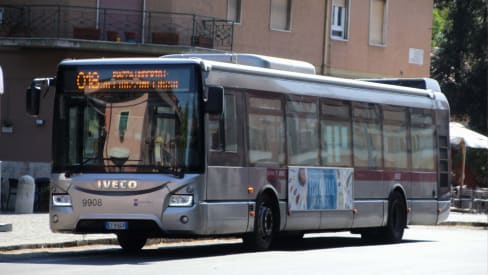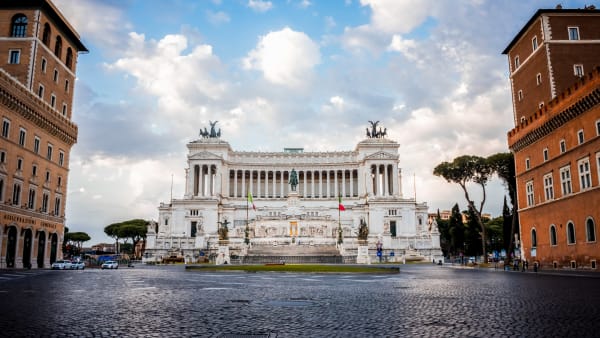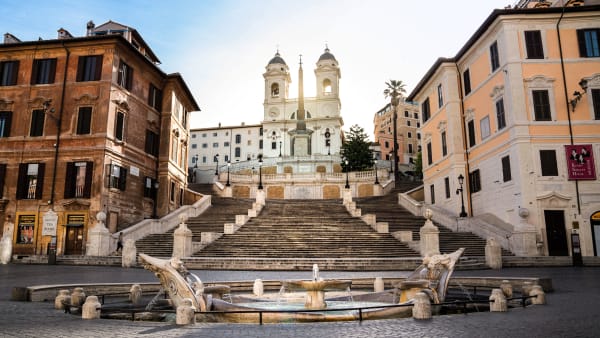Lines
Lines
Daily, 343 city bus lines are operating in Rome. Most of them are managed by ATAC, the company in charge of public transportation in the city. The rest are managed by TPL, a private company.
Regardless of who manages the lines, they are all similar in their operation and share the same fare system. Interesting to know is that lines 60, 74, and 90 employ trolleybuses. Moreover, the recently reactivated lines 117 and 119 use small electric buses to travel through areas in the center of Rome that are difficult to access.
All lines have a classification depending on their schedules, the number of stops, and the zones in which they operate. In total there are six classifications, which are explained below.
| Type of line |
|---|
| Characteristics |
| Details |
| Type of line | Urban “u” | Night “n” | Express “x” | Exact “e” | Maritime “m” | Regional |
|---|---|---|---|---|---|---|
| Characteristics | The most common ones. They have many stops and operate until midnight. | They operate between midnight and 5:30 am. Some of them replace the subway and suburban train. | They make few stops and have high frequencies. Useful to cover certain routes in a short time. | These are peripheral lines with very few stops and established schedules. They’re not very popular among visitors. | They operate between May and September and are useful to visit the beaches of Rome. | They’re useful to reach any destination within the Lazio region but they have a different fare system. |
| Details | See details | See details | See details | See details | See details | See details |
Stops and interesting lines
The metro is certainly the best way to visit popular sights such as the Vatican, Colosseum, Roman Forum, or Piazza di Spagna. However, the route of its lines doesn’t cover every part of the center, while many sites of interest are located in that area.
To visit certain attractions, it’s necessary to walk or take a bus. Some of the lines that might be useful in these cases are the following:
| Line |
|---|
| Details |
| Line | 40 | 64 | 62 | 81 | 115 | 119 | 70 |
|---|---|---|---|---|---|---|---|
| Details | The Express line is very useful for tourists. It stops at Termini, Piazza Venezia, Torre Argentina, and Piazza Pia (very close to the Vatican, next to Castel Sant’Angelo). | An urban line with a similar route to line 40, except with more stops along the way. | An urban line connecting the Vatican area with Tiburtina. | An urban line connecting the Vatican with the southeast of Rome, passing along sites of great tourist interest such as the Circus Maximus, the Roman Forum, and the Colosseum. | An urban line that uses small electric buses. It’s useful to reach the Gianicolense Park from the Castel Sant’Angelo area. | Another urban line that uses electric buses but connects Piazza Venezia with Piazza del Popolo, passing through Piazza di Spagna. | An urban line that supports the Roma-Lido line of suburban trains. It’s useful to reach the coast, but not to visit Ostia Antica. |
When traveling on any of these lines, it’s important to keep an eye on your belongings. The buses on these routes tend to be overcrowded at certain times and during specific seasons, which is an ideal scenario for pickpockets.
Urban lines (u)
These are the most common lines. The buses stop at all stops and they’re certainly the ones you’ll use often during your stay in Rome.
Each line has its schedule but usually, they all start driving between 5:00 am and 6:30 am. In the evening, the last bus leaves the initial stop at midnight, although some urban lines have extended schedules until 2:00 am.
You can identify urban lines by the blue color and the letter “u” on the information displays at any stop.
Night lines (n)
Most of the 31 night lines operate from midnight to approximately 5:30 am.
Some of these lines cover the same routes as the subway and one of the suburban train routes. They usually start operating when these two means of transportation close their stations (with a frequency of 15 minutes).
Buses on these routes make stops at each station on the subway or suburban train line they replace, so they can be useful in case you missed the last train. The lines in question are as follows:
| Line |
|---|
| Replaces |
| Line | nMA | nMB | nMB1 | nMC | nME |
|---|---|---|---|---|---|
| Replaces | Metro line A | Metro line B | Branch B1 of metro line B | Metro line C | Line Roma-Lido of the suburban train. |
There are a few other lines that cover tram routes but they are generally of little interest to visitors.
On the information displays at the stops, you can identify the night lines by the dark blue color and the prefix “n”.
Express lines (x)
In total, there are 12 express lines characterized by high frequencies and few stops. They’re very efficient in connecting distant areas within Rome in relatively short times. Besides, they can be useful for specific routes such as the one from Termini to Castel Sant’Angelo, covered by line 40.
You can identify express lines by the green color and the letter “x” on the information displays at any stop.
Exact lines (e)
They are the minority. The lines are operated by TPL with quite strict timetables, few stops, and are mostly peripheral. They are of little tourist interest and it’s unlikely that you’ll need to use them during your stay in Rome.
They can be recognized at any stop by the brown color and the letter “e” on the information displays.
Maritime lines (m)
During summer (usually from May to September), ATAC operates three lines that allow better mobility along the coast. These are the maritime lines, which could be useful to explore some of the beaches in the area after visiting Ostia Antica, a place you can easily reach using the Roma-Lido line of the suburban trains.
The maritime lines are 07, 062, and 068. They can be identified by the green aqua color and the letter “m” on the information displays at the stops.
Regional lines
In addition to city buses, Rome is also covered by regional buses (blue colored) operated by COTRAL. The regional network of this company is very dense and connects all the towns of the Lazio region.
It’s unlikely that you’ll need to use them during your stay unless you wish to visit some destinations around Rome which aren’t covered by regional trains or suburban trains.















